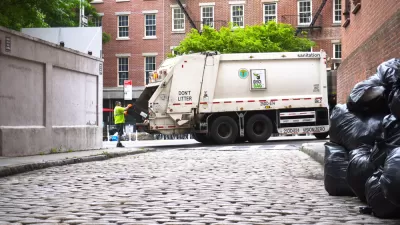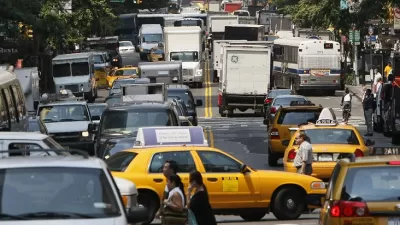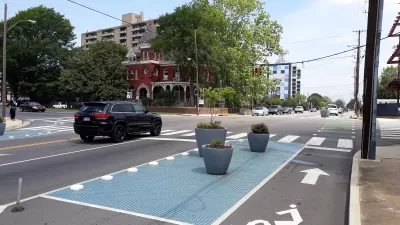Tired drivers working long hours in damaged trucks makes private garbage collection a dangerous business.

Last year, private sanitation trucks killed seven people in New York. Waste collection in the city can be particularly dangerous on the private side of the business, because of the many hours drivers are expected to work and the often poorly-maintained equipment they operate. "Working 10- to 14-hour days, six days per week, means that no one is ever anything close to rested," Kiera Feldman reports for ProPublica. "After working a double shift that lasted nearly 23 hours in August 2016, Queens County Carting driver William Bonds was fired after refusing to work another double shift less than two days later," Feldman writes.
Public sanitation trucks haven't caused a death since 2014, likely because the working conditions are safer for drivers working for the city.
When Feldman found a driver who let her ride with him, she discovered that he had sustained multiple work-related wounds, his truck lacked a gas cap, and he and his helper had to provide their own gloves. "He wore a blue and white striped polo shirt, and neither he nor Caban wore reflective vests — they said #1 Waste hadn’t provided any safety equipment. Workers say that’s common in the industry," Feldman wrote.
One measure that might make garbage collection safer in the city would be to divide the city into zones. Routes that zigzag around the metropolis cause drivers to make long halls regularly, blowing through red lights to try to finish quickly. Companies could be forced to work within certain zones of the city, as they are in Los Angeles and other cities, but the industry’s lobbying has effectively stopped these regulations from passing. "Today, again, zoning has the support of the de Blasio administration but legislation has yet to be introduced in the City Council — and the industry is still resisting. In 2016, the haulers launched NYRWM, which has spent $298,000 lobbying city officials," Feldman reports.
FULL STORY: Trashed: Inside the Deadly World of Private Garbage Collection

Study: Maui’s Plan to Convert Vacation Rentals to Long-Term Housing Could Cause Nearly $1 Billion Economic Loss
The plan would reduce visitor accommodation by 25,% resulting in 1,900 jobs lost.

North Texas Transit Leaders Tout Benefits of TOD for Growing Region
At a summit focused on transit-oriented development, policymakers discussed how North Texas’ expanded light rail system can serve as a tool for economic growth.

Why Should We Subsidize Public Transportation?
Many public transit agencies face financial stress due to rising costs, declining fare revenue, and declining subsidies. Transit advocates must provide a strong business case for increasing public transit funding.

How to Make US Trains Faster
Changes to boarding platforms and a switch to electric trains could improve U.S. passenger rail service without the added cost of high-speed rail.

Columbia’s Revitalized ‘Loop’ Is a Hub for Local Entrepreneurs
A focus on small businesses is helping a commercial corridor in Columbia, Missouri thrive.

Invasive Insect Threatens Minnesota’s Ash Forests
The Emerald Ash Borer is a rapidly spreading invasive pest threatening Minnesota’s ash trees, and homeowners are encouraged to plant diverse replacement species, avoid moving ash firewood, and monitor for signs of infestation.
Urban Design for Planners 1: Software Tools
This six-course series explores essential urban design concepts using open source software and equips planners with the tools they need to participate fully in the urban design process.
Planning for Universal Design
Learn the tools for implementing Universal Design in planning regulations.
City of Santa Clarita
Ascent Environmental
Institute for Housing and Urban Development Studies (IHS)
City of Grandview
Harvard GSD Executive Education
Toledo-Lucas County Plan Commissions
Salt Lake City
NYU Wagner Graduate School of Public Service





























